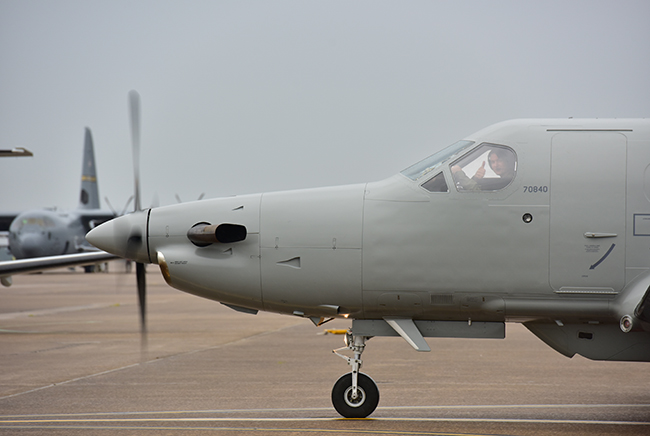
A U-28A crewmember assigned to Hurlburt Field, Fla., gives the thumbs up as he taxis past C-130Js to to the runway for take-off on Sept. 12, 2017, at Little Rock AFB, Ark. Air Force photo by SSgt. Jeremy McGuffin.
The Air Force and US Special Operations Command are testing out technology that could spell trouble for certain small fleets of highly specialized intelligence, surveillance, and reconnaissance aircraft—but the details are murky.
When asked Sept. 18 at AFA’s Air, Space & Cyber Conference which of those platforms the Air Force could afford to ditch in upcoming budgets without causing dire intel capability gaps, Lt. Gen. VeraLinn “Dash” Jamieson, the service’s deputy chief of staff for ISR and cyber effects operations, indicated the military is already moving in that direction.
“We have partnered with SOCOM to look at, how do we automate manual tasks so that we can remote and perhaps go to some more autonomous capability” Jamieson said. “We actually tested out several capabilities and we’re looking at continuing that effort so that we can transition to a more autonomous ability. So you could get rid of certain things that maybe are very niche-oriented and have something that you could program to do more than one operation.”
She did not name specific aircraft but told Air Force Magazine the technology is under consideration for SOCOM platforms at the moment. Air Force Special Operations Command flies aircraft such as the U-28, MC-12, and MQ-9 for ISR missions.
“How do we take a number of humans in the loop, put them on the loop, and automate some of that, understanding infusing of data to get at their targeting problem” Jamieson said.
When people are “in the loop,” it means they are involved in every step of an aircraft’s decision-making process. When they are “on the loop,” it means technology is crunching more information and making certain choices on its own.
Jamieson told Air Force Magazine the military is assessing the feasibility of putting the autonomy capabilities into SOCOM platforms “as fast as the technology bears out.” The effort began a year and a half ago and is now starting to bear fruit, she said. It is not something developed by the Pentagon’s Joint Artificial Intelligence Center.
“It’s the data-crunching and it’s the fusing and giving a good picture from that,” Jamieson said.
The three-star general is set to retire Nov. 7 and will be succeeded by Maj. Gen. Mary O’Brien, who is expected to pin on a third star herself.